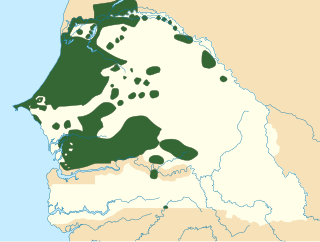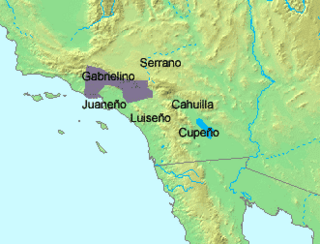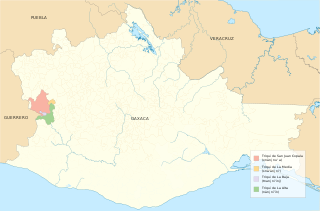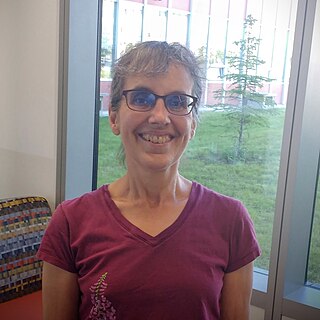Related Research Articles
Mobilian Jargon was a pidgin used as a lingua franca among Native American groups living along the Gulf of Mexico around the time of European settlement of the region. It was the main language among Indian tribes in this area, mainly Louisiana. There is evidence indicating its existence as early as the late 17th to early 18th century. The Indian groups that are said to have used it were the Alabama, Apalachee, Biloxi, Chacato, Pakana, Pascagoula, Taensa, Tunica, Caddo, Chickasaw, Houma, Choctaw, Chitimacha, Natchez, and Ofo. The name is thought to refer to the Mobile Indians of the central Gulf Coast, but did not originate from this group; Mobilian Jargon is linguistically and grammatically different from the language traditionally spoken by the Mobile Indians.

Wolof is a language of Senegal, Mauritania, and the Gambia, and the native language of the Wolof people. Like the neighbouring languages Serer and Fula, it belongs to the Senegambian branch of the Niger–Congo language family. Unlike most other languages of the Niger-Congo family, Wolof is not a tonal language.
Robert D. Van Valin Jr. is an American linguist and the principal researcher behind the development of Role and Reference Grammar, a functional theory of grammar encompassing syntax, semantics, and discourse pragmatics. His 1997 book Syntax: structure, meaning and function is an attempt to provide a model for syntactic analysis which is just as relevant for languages like Dyirbal and Lakhota as it is for more commonly studied Indo-European languages.

The Choctaw language, spoken by the Choctaw, an Indigenous people of the Southeastern Woodlands, is part of the Muskogean language family. Chickasaw is a separate but closely related language to Choctaw.

Uto-Aztecan, Uto-Aztekan or Uto-Nahuatl is a family of indigenous languages of the Americas, consisting of over thirty languages. Uto-Aztecan languages are found almost entirely in the Western United States and Mexico. The name of the language family was created to show that it includes both the Ute language of Utah and the Nahuan languages of Mexico.

The Chickasaw language is a Native American language of the Muskogean family. It is agglutinative and follows the word order pattern of subject–object–verb (SOV). The language is closely related to, though perhaps not entirely mutually intelligible with, Choctaw. It is spoken by the Chickasaw tribe, now residing in Southeast Oklahoma, centered on Ada.

Numic is a branch of the Uto-Aztecan language family. It includes seven languages spoken by Native American peoples traditionally living in the Great Basin, Colorado River basin, Snake River basin, and southern Great Plains. The word Numic comes from the cognate word in all Numic languages for "person." For example, in the three Central Numic languages and the two Western Numic languages it is. In Kawaiisu it is and in Colorado River, and.
Johanna Nichols is an American linguist and professor emerita in the Department of Slavic Languages and Literatures at the University of California, Berkeley.
Larry M. Hyman is Distinguished Professor Emeritus of Linguistics at the University of California, Berkeley. He specializes in phonology and has particular interest in African languages.

The Tongva language is an extinct Uto-Aztecan language formerly spoken by the Tongva, a Native American people who have lived in and around modern day Los Angeles for centuries. It has not been a language of everyday conversation since the 1940s. The Gabrielino people now speak English but a few are attempting to revive their language by using it in everyday conversation and ceremonial contexts. Presently, Gabrielino is also being used in language revitalization classes and in some public discussion regarding religious and environmental issues. Tongva is closely related to Serrano. The names of several cities and neighborhoods in Southern California are of Tongva origin, and include Pacoima, Tujunga, Topanga, Azusa, Cahuenga in Cahuenga Pass and Cucamonga in Rancho Cucamonga.

The Zapotec languages are a group of around 50 closely related indigenous Mesoamerican languages that constitute a main branch of the Oto-Manguean language family and which is spoken by the Zapotec people from the southwestern-central highlands of Mexico. A 2020 census reports nearly half a million speakers, with the majority inhabiting the state of Oaxaca. Zapotec-speaking communities are also found in the neighboring states of Puebla, Veracruz, and Guerrero. Labor migration has also brought a number of native Zapotec speakers to the United States, particularly in California and New Jersey. Most Zapotec-speaking communities are highly bilingual in Spanish.
Yavapai is an Upland Yuman language, spoken by Yavapai people in central and western Arizona. There are four dialects: Kwevkepaya, Wipukpaya, Tolkepaya, and Yavepe. Linguistic studies of the Kwevkepaya (Southern), Tolkepaya (Western), Wipukepa, and Yavepe (Prescott) dialects have been published.

The Triqui, or Trique, languages are a family of Oto-Manguean spoken by 30,000 Trique people of the Mexican states of Oaxaca and the state of Baja California in 2007. They are also spoken by 5,000 immigrants to the United States. Triqui languages belong to the Mixtecan branch together with the Mixtec languages and Cuicatec.
Mohave or Mojave is the native language of the Mohave people along the Colorado River in northwestern Arizona, southeastern California, and southwestern Nevada. Approximately 70% of the speakers reside in Arizona, while approximately 30% reside in California. It belongs to the River branch of the Yuman language family, together with Quechan and Maricopa.
Margaret Langdon was a US linguist who studied and documented many languages of the American Southwest and California, including Kumeyaay, Northern Diegueño (Ipai), and Luiseño.
Tlacolula Valley Zapotec or Valley Zapotec, known by its regional name Dizhsa, and formerly known by the varietal name Guelavia Zapotec is a Zapotec language of Oaxaca, Mexico.
Judith Lillian Aissen is an American professor emerita in linguistics at the University of California, Santa Cruz.

Keren D. Rice is a Canadian linguist. She is a professor of linguistics and serves as the Director of the Centre for Aboriginal Initiatives at the University of Toronto.
Maria “Masha” Polinsky is an American linguist specializing in theoretical syntax and study of heritage languages.
Felipe H. Lopez is a Zapotec-language scholar and writer.
References
- ↑ Date information sourced from Library of Congress Authorities data, via corresponding WorldCat Identities linked authority file (LAF) . Retrieved on 2008-05-08.
- ↑ "Get to Know Your Instructors: Pamela Munro – 2019 LSA Linguistic Institute". lsa2019.ucdavis.edu. Retrieved 2019-07-10.
- ↑ "UC San Diego - Linguistics People - Alumni". ling.ucsd.edu. Retrieved 2018-09-01.
- ↑ Oswalt, Robert L. (1980). "Review of Mojave Syntax" (PDF).
- ↑ "Google Scholar". scholar.google.se. Retrieved 2018-09-01.
- ↑ "Foundation For Endangered Languages. Home" . Retrieved 2012-09-02.
- ↑ "Featured Articles about Pamela Munro - Page 2 - latimes". articles.latimes.com. Retrieved 2018-09-01.
- ↑ "LSA 2019 Linguistic Institute | Linguistic Society of America". www.linguisticsociety.org. Retrieved 2019-07-10.